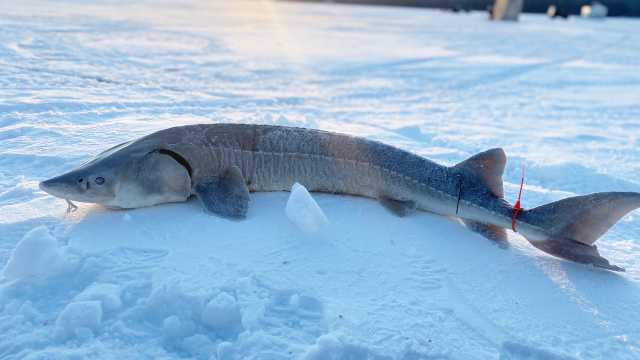After only 36 minutes of fishing, this year’s sturgeon season on Black Lake (in Cheboygan and Presque Isle counties) ended at 8:36 a.m. Saturday, Feb. 5. The season, which included spearing and hook-and-line fishing, was scheduled to run Feb. 5-9, or until the harvest limit quota of six lake sturgeon had been reached.
Anglers initially were allocated a season quota of seven sturgeon, but the Michigan Department of Natural Resources set the harvest limit at six fish. This action helps accommodate the expected number of anglers and anticipate the possibility of near-simultaneous harvest of more than one fish.
There were 565 registered anglers, including a good number of supervised youth. According to the DNR, five sturgeon harvested were male and one was a female, ranging from 46 to 62 inches long and 23 to 67 pounds in weight.
–The first fish was a 59.5-inch female that weighed 48 pounds.
–Fish number two, the largest fish, was a 62-inch male that weighed 67 pounds.
–Fish three was a 47-inch male that checked in at 25 pounds.
–Fish four was a 57-inch male that weighed 45 pounds.
–The fifth fish was a 46-inch male that weighed 23 pounds.
–The sixth fish was a 56-inch male that weighed 35 pounds.
All six harvested fish taken had been captured before by Michigan State University and the DNR during spring spawning runs in the Black River or from past surveys of Black Lake. The harvested 62-inch male originally was captured in every other year in the spawning run from 2002 through 2020. The 57-inch male had been captured and tagged during the 2002, 2006, 2007, 2009, 2013, 2019 and 2021 spawning runs in the Black River. The 56-inch male had been captured in the 2013, 2016, 2017, 2019 and 2021 spawning runs. In addition, the 47-inch male had been tagged in the 2006, 2010 and 2012 spawning runs.
Participating anglers were notified of the season closure in a variety of ways, mainly from nearly instantaneous text alerts and ice shanty visits from DNR personnel. All methods were used to indicate the season’s end within minutes of the final fish being harvested. DNR law enforcement officials and other department personnel again were embedded in the on-ice fishing communities and were able to quickly and safely report harvested fish this year, as well as to quickly contact all lake sturgeon anglers on the ice and close the season.
Rehabilitation of lake sturgeon in the Cheboygan River watershed is a cooperative effort involving the DNR, the Black Lake Chapter of Sturgeon For Tomorrow, Michigan State University, Tower-Kleber Limited Partnership, the Bay Mills Indian Community, the Grand Traverse Band of Ottawa and Chippewa Indians, the Little River Band of Ottawa Indians, the Little Traverse Bay Band of Odawa Indians and the Sault Ste. Marie Tribe of Chippewa Indians.







